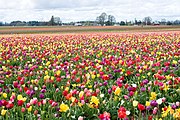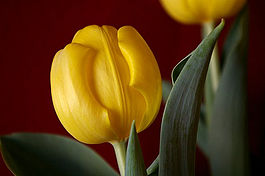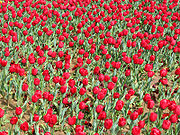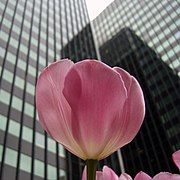SearchProduct Type
|
Add us to: Favorite Stores Item's weight: less then 1 g.
Stamp Authenticity Since 1939 till 1990 Lithuania suffered 3 occupations: 1 German (1941-1944) and 2 Soviet (1939-1941, 1944-1990), one of which lasted 46 years. In WWII occupations were based on violent battles between Germans and Russians. These historical events left a lot of stuff behind them selves. Almost every family in Lithuania has something left, related to USSR history in their forgotten drawers. So we are just traveling around lithuanian countrysides and collecting this memorabilia. Item is original, genuine, authentic, unique, not a copy or replica - has 2-12 decades of it's own unique history.
Tulipa commonly called Tulip is a genus of about 100 species of bulbous flowering plants in the family Liliaceae. The native range of the species includes southern Europe, north Africa, and Asia from Anatolia and Iran in the east to northeast of China. The centre of diversity of the genus is in the Pamir and Hindu Kush mountains and the steppes of Kazakhstan. A number of species and many hybrid cultivars are grown in gardens, used as pot plants or as fresh cut flowers. DescriptionThe species are perennials from bulbs, the tunicate bulbs are often produced on the ends of stolons and covered with glabrous to variously hairy papery coverings. The species include short low growing plants to tall upright plants, growing from 10 to 70 centimeters (4–27 in) tall. Plants with typically 2 to 6 leaves, with some species having up to 12 leaves. The cauline foliage is strap-shaped, waxy-coated, usually light to medium green and alternately arranged. The blades are somewhat fleshy and linear to oblong in shape. The large flowers are produced on scapes or subscapose stems normally lacking bracts. The stems have no leaves to a few leaves, with large species having some leaves and smaller species have none. Typically species have one flower per stem but a few species have up to four flowers. The colorful and attractive cup shaped flowers have three petals and three sepals, which are most often termed tepals because they are nearly identical. The six petaloid tepals are often marked near the bases with darker markings. The flowers have six basifixed, distinct stamens with filaments shorter than the tepals and the stigmas are districtly 3-lobed. The ovaries are superior with three chambers. The 3 angled fruits are leathery textured capsules, ellipsoid to subglobose in shape, containing numerous flat disc-shaped seeds in two rows per locule.[1] Origin of the NameAlthough tulips are associated with Holland, both the flower and its name originated in the Ottoman Empire. The tulip is actually not a Dutch flower as many people tend to believe. The tulip, or "Lale" as it is called in Turkey, is a flower indigenous to Iran, Afghanistan, Turkey and other parts of Central Asia. A Dutch ambassador in Turkey in the 16th century, who was also a great floral enthusiast, Ogier Ghiselin de Busbecq, got their very names because of their Persian origins. Tulips were brought to Europe in the 16th century; the word tulip, which earlier in English appeared in such forms as tulipa or tulipant, entered the language by way of French tulipe and its obsolete form tulipan or by way of Modern Latin tulīpa, from Ottoman Turkish tülbend, "muslin, gauze." (The English word turban, first recorded in English in the 16th century, can also be traced to Ottoman Turkish tülbend.) The Turkish word for gauze, with which turbans can be wrapped, seems to have been used for the flower because a fully opened tulip was thought to resemble a turban. CultivationTulips originate from mountainous areas with temperate climates and need a period of cool dormancy. They do best in climates with long cool springs and early summers, but they are often grown as spring blooming annual plantings in warmer areas of the world. The bulbs are typically planted in late summer and fall, normally from 10 to 20 cm (4 to 8 in.) deep, depending of the type planted, in well draining soils. In parts of the world that do not have long cool springs and early summers, the bulbs are often planted up to 12 inches deep, this provides some protection from the heat of summer and tends to force the plants to regenerate one large bulb each year instead of many smaller non blooming ones. This can extend the usefulness of the plants in warmer areas a few years but not stave off the degradation in bulb size and eventual death of the plants. PropagationTulips can be propagated through offsets, seeds or micropropagation.[2] Offsets and tissue culture methods are means of asexual propagation, they are used to produce genetic clones of the parent plant which maintains cultivar integrity. Seed raised plants show greater variation, and seeds are most often used to propagate species and subspecies or are used for the creation of new hybrids. Many tulip species can cross pollinate with each other; when tulip populations overlap with other species or subspecies, they very often hybridize, producing populations of mixed plants in the wild. Most tulip cultivars are complex hybrids and sterile, those plants that produce seeds produce offspring very dissimilar to the parents. In horticulture, tulips are divided up into fifteen groups mostly based on flower morphology and plant size.[3]
Tulip growers using offsets to produce salable plants need a year or more of growth before plants are large enough to flower; tulips grown from seeds often need five to eight years of growth before the plants are large enough to flower. Commercial growers harvest the bulbs in late summer and they are graded into sizes; bulbs large enough to flower are sorted and sold, while smaller bulbs are sorted into sizes and replanted. Holland is the main producer of commercially sold plants, producing as many as 3 billion bulbs annually. [4] Diseases
Botrytis tulipae is a major fungal disease affecting tulips, causing cell death leading to rotten plants.[5] Other pathogens include Anthracnose, bacterial soft rot, blight caused by Sclerotium rolfsii, bulb nematodes, other rots including blue molds, black molds and mushy rot.[6] Historically variegated varieties admired during the Dutch tulipomania, gained their delicately feathered patterns from an infection with Tulip Breaking potyvirus. The mosaic virus carried by the green peach aphids, Myzus persicae was common in European gardens of the seventeenth century. While the virus produces fantastically colorful flowers, it also caused weakened plants that died slowly. Today the virus is almost eradicated from tulip growers' fields. Those Tulips affected by mosaic virus are called "Broken tulips", they will occasionally revert to a plain or solid coloring, but still remain infected with the virus. Some historical cultivars have had a striped, "feathered", "flamed", or variegated flower, as in the illustration below. While some modern varieties also display multicoloured patterns, this results from a natural change in the upper and lower layers of pigment in the tulip flower. The Black Tulip was the title of a historical romance by Alexandre Dumas, père (1850), in which the city of Haarlem has a reward outstanding for the first grower who can produce a truly black tulip. This fascination with growing a black tulip, a biologically impossible task, was historically accurate to the tulipomania in which the novel is set. Introduction to Western Europe
It is unclear who first brought the Tulip to northwest Europe. The most widely accepted story is that of Oghier Ghislain de Busbecq, Ambassador from Ferdinand I to Suleyman the Magnificent of the Ottoman Empire in 1554. He remarked in a letter that he saw "an abundance of flowers everywhere; Narcissus, hyacinths, and those which in Turkish Lale, much to our astonishment, because it was almost midwinter, a season unfriendly to flowers" (see Busbecq, qtd. in Blunt, 7). It is worth mentioning that the words Narcissus (Narges) and Lale (Laleh) originally come from Persian. In Persian Literature (classic and modern) special attention has been given to these two flowers which looked like the beloved eyes to Narges and a glass of wine to Laleh. By 1559, an account by Conrad Gessner described tulips flowering in Augsburg, Bavaria in the garden of Councillor Herwart. Due to the nature of the tulip's growing cycle, the bulbs are generally removed from the ground in June, and they must be replanted by September to endure the winter. Busbecq's account of the supposed first sighting of tulips by a European is likely spurious. While possible, it is doubtful that Busbecq could successfully have had the tulip bulbs removed, shipped, and replanted between his first sighting of them in March 1558 and Gessner's description in 1559. After introduction of the Tulip to Europe, it gained much popularity and was seen as a sign of abundance and indulgence in the Ottoman Empire. The era during which the Ottoman Empire was wealthiest is called the Tulip era, or Lale Devri in Turkish. Another oft-quoted account is that of Lopo Vaz de Sampayo, governor of the Portuguese possessions in India. When he returned to Portugal in disgrace after usurping his position from the rightful governor, Sampayo supposedly took tulip bulbs with him from Sri Lanka. This tale too, however, does not hold up to scrutiny because tulips do not occur in Sri Lanka and the island itself is far from the route Sampayo's ships should have taken. Regardless of how the flower originally arrived in Europe, its popularity soared quickly. Charles de L'Ecluse (Clusius) is largely responsible for the spread of tulip bulbs in the final years of the sixteenth century. He was the author of the first major work on tulips, completed in 1592. Clusius had already begun to note and remark upon the variations in colour that made the tulip so admired and his admiration of them quickly spread to others. While occupying a chair in the medical faculty of the University of Leiden, Clusius planted both a teaching garden and his own private plot with tulip bulbs. In 1596 and 1598 Clusius suffered thefts from his garden, with over a hundred bulbs stolen in a single raid. Between 1634 and 1637, the early enthusiasm for the new flowers triggered a speculative frenzy now known as the tulip mania and tulip bulbs were then considered a form of currency. The Netherlands are still associated with tulips and the term 'Dutch tulips' is often used for the cultivated forms. Tulip Festivals are held in the Netherlands, Spalding (England) and in North America every May, including the three week annual Canadian Tulip Festival in Ottawa, Canada. Tulips are now also popular in Australia, and several festivals are held during September and October in the Southern Hemisphere's spring. The world's largest permanent display of tulips, although open to the public only seasonally, is in Keukenhof, in the Netherlands.
Selected species
References
Bolshoi Theatre
The Bolshoi Theatre (Russian: Большой театр, Bol'shoy Teatr, Great Theatre) is a historic theatre in Moscow, Russia, designed by famed architect Joseph Bové, which holds performances of ballet and opera. History
The company was founded in 1776 by Prince Peter Urussov and Michael Maddox. Initially, it held performances in a private home, but in 1780, it acquired the Petrovka Theatre and began producing plays and operas. The current building was built on Theatre Square in 1824 to replace the Petrovka Theatre, which had been destroyed by fire in 1805. It was designed by architect Andrei Mikhailov, who had built the nearby Maly Theatre in 1824. At that time, all Russian theatres were imperial property. Moscow and St Petersburg each had only two theatres, one intended for opera and ballet (these were known as the Bolshoi Theatres), and one for plays (tragedies and comedies). As opera and ballet were considered nobler than drama, the opera houses were named "Grand Theatres" ("Bolshoi" being the Russian for "large" or "grand") and the drama theatres were called "Smaller Theatre" ("Maly" being the Russian for "small," "lesser," or "little"). The Bolshoi Theatre's original name was the Imperial Bolshoi Theatre of Moscow, while the St. Petersburg Bolshoi Theatre (demolished in 1886), was called the Imperial Bolshoi Kamenny Theatre. The Moscow theatre was inaugurated on 18 January 1825 with a performance of Fernando Sor's ballet, Cendrillon. Initially, it presented only Russian works, but foreign composers entered the repertoire starting around 1840. A fire in 1853 caused extensive damage; reconstruction was carried out by Albert Kavos, son of Caterino Kavos, an opera composer. The theater reopened in 1856. During World War II, the theatre was damaged by a bomb, but it was promptly repaired. The Bolshoi has been the site of many historic premieres including Tchaikovsky's Voyevoda and Mazeppa, and Rachmaninoff's Aleko and Francesca da Rimini. Ballet and operaThe Bolshoi is a repertory theatre, meaning that it draws from a stable of productions, any one of which may be performed on a given evening. It normally introduces two to four new ballet or opera productions each season and retires a similar number. The sets and costumes for most productions are made in the Bolshoi's own workshops. The performers are drawn primarily from the Bolshoi's regular ballet and opera companies, with occasional guest performances. Since the collapse of the Soviet Union, there have been a few attempts to reduce the theatre's traditional dependence on large state subsidies. Corporate sponsorship occurs for some productions, but state subsidy is still the lifeblood of the company. The Bolshoi has been associated from its beginnings with ballet. Tchaikovsky's ballet Swan Lake premiered at the theatre on Saturday, March 4, 1877. Other staples of the Bolshoi repertoire include Tchaikovsky's Sleeping Beauty and The Nutcracker, Adam's Giselle, Prokofiev's Romeo and Juliet, and Khachaturian's Spartacus. After the death of Stalin, international touring companies from the Bolshoi became an important source of cultural prestige, as well as foreign currency earnings, and as a result the "Bolshoi Ballet" became a well-known name in the West. Bolshoi-related troupes continue to tour regularly in the post-Soviet era. The opera company specializes in the classics of Russian opera such as Mussorgsky's Boris Godunov, Glinka's A Life for the Tsar, and Rimsky-Korsakov's The Tsar's Bride, as well as the operas of Tchaikovsky. Many operas by western composers are also performed, especially works of Italian composers such as Rossini, Verdi, and Puccini. Until the mid-1990s, most foreign operas were sung in Russian, but Italian and other languages have been heard more frequently on the Bolshoi stage in recent years. Some operas, such as Borodin's Prince Igor, include extensive ballet sequences. Many productions, especially of classic Russian opera, are given on a scale of grand spectacle, and can have dozens of costumed singers and dancers on stage for crowd or festival scenes. Current status of the BolshoiThe main Bolshoi Theatre closed for restoration in 2005, and, as of early 2008, is scheduled to reopen in 2009 with the theatre making its first performance in November.[1] The Theatre has undergone many renovations in its lifetime, but none as major as this. The restoration will cost $US730 million (The restoration was initially due to cost 15 billion roubles ($610 million) but engineers found the structure was more than 75 percent unstable)[2], and is funded entirely by the federal government.[3] The restoration will repair the foundation and brickwork. The renovation is intended to restore the original acoustics of the theatre, which were largely lost as a result of renovations during the Soviet era.[4] Inside the theatre, the entire space has been stripped from the bottom up, the 19th-century wooden fixtures, silver stage curtain and French-made red velvet banquettes removed for repair in specialist workshops. At the very top of the facade, the two-headed eagle of the original Russian coat of arms has been installed in place where the Soviet sickle and hammer hung for decades. The New Bolshoi Theatre, adjacent to the original and built incredibly in only six months, continues to stage an extensive repertory of concerts and performances. Since these two theatres are the most famous in Moscow, they are usually frequented by tourists, and the prices can be correspondingly much more expensive when compared to other Russian theatres, particularly for ballets, where the prices are comparable to those for performances in the West. Concerts and operas are still relatively affordable, with prices in the 300 to 2,000 rouble range for good par-terre (main floor) or balcony seats (US$1 = approximately 25 roubles). Prices do go up every year, however. Notes
Music directors
References
The free listing tool. List your items fast and easy and manage your active items.
| Return
Items must be returned within 30 days .
Refund will be given as Money back. Refund policy details: Return is accepted at any reason. Item(s) must arrive to us not later then 30 days after it was shipped out (you will be informed about this immediately after it will be done). Returned items must be the same item in the exact same condition as originally shipped. Refunds are for the final eBay item purchase price only, less a 10% restocking fee. Shipping costs, insurance, and handling charges (if any) are non refundable. Returns must be shipped insured. Shipping
Payment Method
Insurance
Not Offered (Domestic)
|
Shopping Cart |
||||||||||||||||||||||||||||||||||||||||||||||||||||||||||||||||||||||||||||||||||||||||||||||













